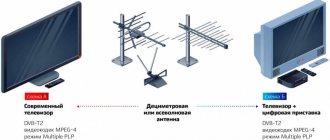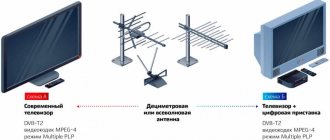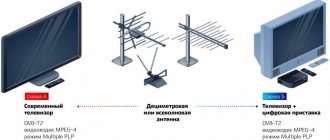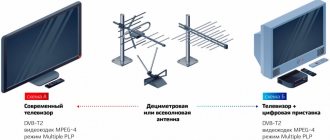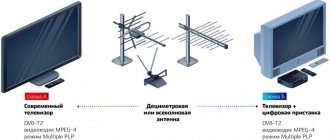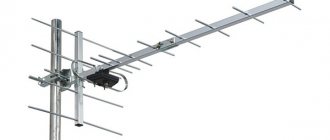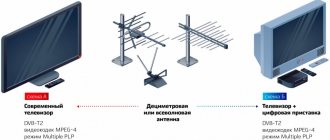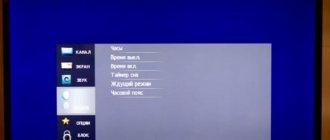How to set up and connect digital TV on a TV in Kirov
Since January 2019, Russia and its regions have been switching from analogue to digital television signals in several stages. This allows you not only to improve the quality of image and sound, but also to increase the number of free channels. Finally, all settlements in Russia, according to information from representatives of the Ministry of Digital Development, Communications and Mass Communications of the Russian Federation, will be able to switch to digital before October 14, 2021. We will tell you what actions need to be performed at home or in the country when your region completely switches to digital TV.
In connection with the mentioned transition to digital broadcasting, those people who watch TV through an antenna, in some cases need to tune in to receive a digital signal. How can I tell if my television is digital or not? If, when you turn on the TV, instead of the usual TV programs you see a video about how to switch to digital, then you have analog television, and you need to perform a number of actions. The absence of an information video means that: you initially have digital television (satellite or Internet TV); you have terrestrial television, but the transition to digital broadcasting has already been completed; Do you have cable TV? The authorities agreed with cable television operators to preserve analogue broadcasting in the cable. But if you want, you can also switch to digital broadcasting in cable. Please note: if you have several TVs at home or in the country, they can receive a TV signal in different ways. For example, in the living room the TV is connected to cable TV, and in the kitchen the reception is via an antenna. How to set up digital TV at your dacha? Before the start of the summer season, we recommend that you find out in advance what type of signal the TV receives in your country house. If you have satellite TV, you don't need to do anything. But if you receive a TV signal using an antenna, prepare in advance to switch to digital TV. How to set up digital if I watch TV through an antenna?
If you have analogue television (there is an “A” next to the central channel logos), find out whether your TV supports the DVB-T2 standard. Digital TVs released after 2012 mostly have a corresponding decoder; those released earlier may not support this format (this is especially true for older analog TVs). You can check whether your TV supports the DVB-T2 standard in the instructions for the TV or using the “Search for information about TV” service on the website of the Russian Television and Radio Broadcasting Network (RTRS). You will need to enter the make and model of your TV. If your TV supports DVB-T2, you just need to set up your TV using the remote: Step 1: Turn off the TV's power. Step 2: Connect the antenna cable to the antenna input of your digital TV. Step 3: Connect the power and turn on the TV. Step 4. Go to the appropriate section of the TV settings menu and activate the digital tuner. Step 5. Automatically search for programs using the instruction manual. You can perform a manual channel search. In this case, you must enter the channel number or frequency. If your TV does not support this format, you need to purchase additional equipment - a digital set-top box (receiver). If you have two TVs that you watch through an antenna, and you want to watch different channels on them, you need to purchase a set-top box for each of them. The digital set-top box needs to be connected to the TV and configured: Step 1. Turn off the power to the TV. Step 2. Connect the antenna cable to the antenna input of the digital set-top box. Connect the video and audio cables to the appropriate jacks on your TV and set-top box. The image quality will be higher when connecting the set-top box to the TV with an HDMI cable. Step 3: Connect the power and turn on the TV. Step 4. From the menu, select the required input source: HDMI, AV, SCART and others. Step 5. Automatically search for digital TV programs using the operating instructions. You can perform a manual search. In this case, you must enter the channel number or frequency. You can also find more information on how to connect digital TV, choose a digital set-top box, where to buy it and how to set it up, on the website of the mentioned Russian Television and Radio Broadcasting Network (RTRS), where, depending on your region, you must call the hotline They will tell you how to troubleshoot possible problems. How can I retune my TV to digital if I have cable TV? If you have cable television and want to set up a digital signal, you need to: Step 1. Enter the menu using the special button on the remote control. Step 2. Go to the “Channel” section, which usually has a satellite dish icon. Step 3. Select "Auto search". Step 4. Select “Cable” from the proposed connection options. Step 5. Next, select “Digital” and click on “Start”. Step 6: If you want to keep the analog channels, select “Analog and Digital”. If you have any additional questions, you can contact your operator's support team. Please note: if you receive a TV signal through cable, but still see an informational video about switching to digital broadcasting, you will need to contact your cable operator's customer service and ask about how you can connect to digital TV within the current tariff. What channels will be available to me after switching to digital TV? If you watch television through an antenna, after switching to a digital signal, 20 mandatory TV channels of the first and second multiplexes will be available to you. The first multiplex includes: Channel One, “Russia 1”, “Match TV”, NTV, “Petersburg - Channel Five”, “Culture”, “Russia 24”, “Carousel”, OTR, “TV Center - Moscow”. The second multiplex includes: REN TV, Spas, STS, Domashny, TV-3, Friday!, Zvezda, Mir, TNT, Muz-TV). If you have cable television, you will have access to those channels that are provided for in your agreement with the operator. At the same time, by agreement between regional authorities and operators, more than 50 TV channels will be available in digital quality, the mos.ru portal reports. Earlier, the Ministry of Telecom and Mass Communications approved a plan for a phased disconnection from analogue television and radio broadcasting in the constituent entities of the Russian Federation as part of the transition to digital in December 2021. The switch-off from analogue broadcasting was decided to be divided into three stages from January to June 2021, namely February 11, April 15 and June 3. During the first wave of transition to digital, analogue TV was replaced in the Penza, Magadan, Ryazan, Ulyanovsk, Tula, Yaroslavl regions, as well as in the Chechen Republic. On April 15, another 20 Russian regions switched from analogue to digital television broadcasting. Among those who switched from analogue to digital TV were Moscow, Moscow region, Kalmykia, Mordovia, Karachay-Cherkessia, Chuvashia, Kabardino-Balkaria, Stavropol Territory, Udmurtia, Yamalo-Nenets Autonomous Okrug, as well as Kemerovo, Amur, Ivanovo, Kirov, Kostroma, Kurgan, Lipetsk, Novgorod, Sakhalin, Tyumen regions. It was planned that the transition process would end with the third stage on June 3, when the remaining 57 regions would be transferred to digital. However, the Russian government decided to extend this period and transfer the remaining regions of Russia to digital in October 2021. “The main task that continues to face all regions, regardless of whether they find themselves in the third or fourth stage, is to by June 3, all the necessary work was done. It’s just that residents of some regions that belong to the fourth stage, if fully ready, will receive analog television for some time,” concluded the deputy head of the Ministry of Telecom and Mass Communications. TOTAL, in October 2019, all regions of Russia: Adygea, Altai, Bashkiria, Buryatia, Dagestan, Ingushetia, Kabardino-Balkaria, Kalmykia, Karachay-Cherkess Republic, Karelia, KOMI, Crimea, Mari El, Mordovia, Sakha (Yakutia), North Ossetia (Alania), Tatarstan, TUVA, Udmurtia, Khakassia, Chechnya, Chuvashia, Altai Territory, Transbaikal Territory, Kamchatka Territory, Krasnodar Territory, Krasnoyarsk Territory, Perm Territory, Perm Territory, Primorsky Territory, Stavropol Territory, Khabarovsk Territory, Amur Region, Astrakhan Region, Arkhangelsk Region , Belgorod region, Bryansk region, Vladimir region, Volgograd region, Vologda region, Voronezh region, Ivanovo region, Irkutsk region, Kaliningrad region, Kaluga region, Kemerovo region, Kirov region, Kostroma region, Kurgan region, Kursk region, Leningrad region, Lipitskaya region, Magadan region, Moscow region, Murmansk region, Nizhny Novgorod region, Novgorod region, Novosibirsk region, Omsk region, Orenburg region, Oryol region, Penza region, Pskov region, Rostov region, Ryazan region, Samara region, Saratov region, Sakhalin region, Sverdlovsk region, Smolensk region, Tambov region, Tver region, Tomsk region, Tula region, Tyumen region, Ulyanovsk region, Chelyabinsk region, Yaroslavl region, federal cities - Moscow, St. Petersburg, Sevastopol, Jewish Autonomous Okrug, Khanty-Mansi Autonomous Okrug, Yamal-Nenets Autonomous Okrug, Nenets and Chukotka Autonomous Okrug - will switch completely to digital television.
03.05.2019 11:51
homyak:
07.11.2014 at 20:06
“Digital” has already arrived to us. But we don't know about it
Have you noticed how persistently the state introduces us to the benefits of civilization? From high stands they constantly talk about the need to ensure a high quality of life for Russians. One of the innovations is the transfer of the country to digital television.
October 31, 2014 We have heard a lot about this. Some are already enjoying the new generation of television using the services of digital TV operators operating in the local market. But many, not so “advanced” city residents continue to wait for the “figure” promised by the federal government to come to their homes on its own...
The transition to digital is a global trend associated with the development of new technologies for transmitting video signals. Russia, while maintaining analogue broadcasting, could become an outsider in the information space. There is a fundamental difference between analog and digital television. For example, on one analogue broadcasting frequency there is one channel, and on a digital frequency there are 10. Digital TV is distinguished from analogue by the brightness of colors, image clarity and high-quality stereo sound; under certain conditions, it implies interactivity, that is, the possibility of viewers participating in various surveys , voting, educational programs, etc.
And most importantly, “digitization” promises TV viewers a free broadcast of the most relevant TV channels. A miracle, and that’s all! When will this miracle come to us?
Recently, our editors have received several requests from readers. They ask who and how will provide Kirovo-Chepetsk with free digital television broadcasting?
This is what Viktor Andreevich Mikryukov, who lives on the street, writes. Engels: “I read somewhere that the Kirov region is already 72% provided with free digital television, and we live 18 kilometers from Kirov, we didn’t have it and still don’t have it. There are two months left before the end of the announced transition to digital television. Not every pensioner can afford to connect to cable television or use the services of other operators. The city administration does not delve into these issues, nor do the housing departments. I would like to receive an answer through the newspaper...”
Decree of the President of the Russian Federation dated June 24, 2009 No. 715 contains a list of 10 TV channels that should “reach” us free of charge: Channel One, TV channels “Russia”, “Russia-2”, “Russia-24”, “Russia - Culture” ", "Public Television of Russia", NTV, "TV, children's and youth television channel "Carousel". (This is the so-called 1st multiplex.) 2nd and 3rd multiplexes are also being formed, 3rd will also include regional (municipal) TV channels.
In September 2009, Vladimir Putin signed the Federal Program for the Development of Television and Radio Broadcasting in the Russian Federation for 2009-2015, according to which by 2015 our country should completely switch from analogue to digital television. In accordance with the order of the Government of the Russian Federation dated September 27, 2011 No. 1676, the Russian Television and Radio Broadcasting Network (RTRS) is the sole executor of activities for the development of a digital terrestrial television and radio broadcasting network in the DVB-T2 standard.
Today, all television companies are recorded in digital format, and then the signal reaches regional transmission centers via satellites (the TV tower in Kirov behind the regional philharmonic is known to everyone). In regional centers, having received a signal from a satellite, it is converted to analog. In this case, the quality of both the “picture” and the sound is lost.
The absence of “transformative” manipulations allows the signal to be transmitted to the audience in its “pristine”, high-quality form. That is, the “picture” on a home TV screen can ideally be the same as on a studio monitor.
The Kirov region, according to the Federal target program “Development of television and radio broadcasting in the Russian Federation for 2009-2015”, is included in the list of regions of the 3rd stage of the introduction of digital television broadcasting in Russia.
The construction of additional television towers has been going on since 2013, so residents of some areas of the Vyatka region are already watching TV in a new format.
I read in the news section on the website of the Kirov branch of RTRS: digital TV broadcasting has begun in the Sovetsky district; the first multiplex is being broadcast in Belaya Kholunitsa and Verkhoshizhemye, Kumeny and Verkhobystritsa; digital television broadcasting facilities were put into operation in Afanasyev, Suna, Yaransk, etc.
And where are we - the second largest city in the Kirov region?
“We have been exploring your city for a long time, conducting diagnostics and analysis,” Andrey Kuzmin, deputy chief engineer of the Kirov branch of RTRS, answers my question. – A stable digital broadcasting signal has been going to Kirovo-Chepetsk for at least a year. Due to dense buildings, it is impossible to “catch” it with an indoor antenna; you need to “catch” it with a collective antenna located on the roof of an apartment building. But the trouble is that the existing systems for collective reception of television and radio broadcasting, which were installed earlier during the construction of houses, have long been outdated.
Therefore, for reliable reception of digital programs, firstly, it is necessary to replace the collective receiving antennas of the meter range with decimeter ones, and also to modernize the distribution devices.
Secondly, you should purchase a special set-top box-receiver for receiving a digital television signal in DVB-T2 format (today there are set-top boxes on sale that cost from 1.3 thousand rubles; there are also more expensive ones, but they have a large number of options) or a TV that receives programs in the digital standard."
To talk about modernizing the so-called antenna industry, you need to understand who is in charge of it today and who to contact.
Deputy Head of Administration Natalya Dvinina reported that today the antenna facilities, like other common property of multi-apartment residential buildings, are maintained by management organizations.
In turn, the housing department of the Consulting group transferred it for maintenance to ZAO AKTV, and the municipal housing office-6 to LLC TMH.
By the way, after an experiment to reconstruct the antenna facilities of part of the houses in the microdistrict. Cheryomushki, carried out by specialists from TMH LLC, residents have been watching a package of the most popular and popular TV channels for free for about 10 years, while paying only a subscription fee for a collective antenna.
These are the nuances that older people don’t know about and don’t know about.
They sit and wait for the free package of TV channels in good quality promised by the federal government.
“City residents who today are “dependent” only on a collective antenna (those who have not connected to cable television and have not installed individual antennas - author) are no more than 5-7%, says Natalya Dvinina. – Mostly these are pensioners. Neither the housing and communal services department nor the consumer protection department have yet received any questions about the possibilities of switching to digital TV. Therefore, the administration does not consider the situation critical. The state has not delegated powers to local governments to assist in this process, but if a problem arises during the broadcast of the first and second TV channels, we, of course, will look for ways to solve it.”
I would especially like to emphasize that the state does not provide for reimbursement of costs associated with the acquisition of an individual set-top box, and even more so for the costs of reconstructing collective reception systems.
However, in some regions, despite the fact that such tasks are not defined in the federal target program, they are thinking about social support measures for low-income categories of the population. Social support measures from regional budgets have been developed in Udmurtia, Leningrad, Kursk, Samara regions, and other constituent entities of the Russian Federation.
Judging by the draft budget of the Kirov region for 2015 and the subsequent period (2016-2017), we should not expect such social bonuses.
I hasten to inform our readers who are concerned that from 2015 analogue television broadcasting will cease, as stated in the federal program, and they will be forced to sit in front of a TV with a blank screen.
They promised to introduce digital television gradually: it will exist on a par with analogue until at least 95% of the country's population is able to receive a digital signal.
Only then will analog TV be abolished as unnecessary. Well, since the planned indicators were not met, this deadline has already been postponed to June 1, 2021.
We propose that the city prosecutor's office take special control over the implementation of the Federal Program for the Development of Television and Radio Broadcasting in Kirovo-Chepetsk, including in terms of ensuring the right of citizens to receive information.
Elena Bushueva. "Kirovets"
It is important to know
In the Kirov region, the first two stages of the construction of a digital television broadcasting network have been completed, which is being implemented within the framework of the Federal program “Development of television and radio broadcasting in the Russian Federation for 2009–2015”, according to which 97.6% of Russians should receive free access to 20 television channels in modern digital as the DVB-T2 standard.
Digital television broadcasting of 1 multiplex is already available to 70% of the region's population, it includes 10 television programs and 3 radio broadcast programs.
Construction of the third phase of digital broadcasting facilities continues. By the end of 2014, 31 objects should be built.
By the end of the year it is planned to begin broadcasting 2 multiplex programs.
As for local programs, according to the Federal State Unitary Enterprise “Space Communications”, the Express-AM6 spacecraft was launched in July.
This communications satellite should ensure the transmission of a television signal to the European part of Russia, including the Kirov region.
After a communication channel is allocated for the Kirov region, the transmission of local programs to the region will begin.
At the Kirov ORTPC, the equipment of the regional multiplex formation center has already been installed and ready for operation.
Approximate dates for the start of distribution of local programs in 1 multiplex per region: end of 2014 – beginning of 2015.
Pay attention to the standard
By the decision of the Government Commission for the Development of Television and Radio Broadcasting of the Russian Federation, digital broadcasting is produced in the DVB-T2 standard, as a result of which the equipment necessary for broadcasting the DVB-T standard, which is offered in retail networks as “digital television receivers”, cannot accept a digital signal of the DVB-T2 format will be able.
Consult with specialists before purchasing set-top boxes or television receivers.
You must purchase televisions and digital set-top boxes that support the DVB-T2 standard.
To connect terrestrial digital television, you must use a regular UHF television antenna.
The antenna can be either indoor or outdoor.
Its characteristics are individual for each subscriber and depend on the distance from the radio and television station and, as a consequence, the level of the received signal.
chepetsk-news.ru/archives/59219
Answer
